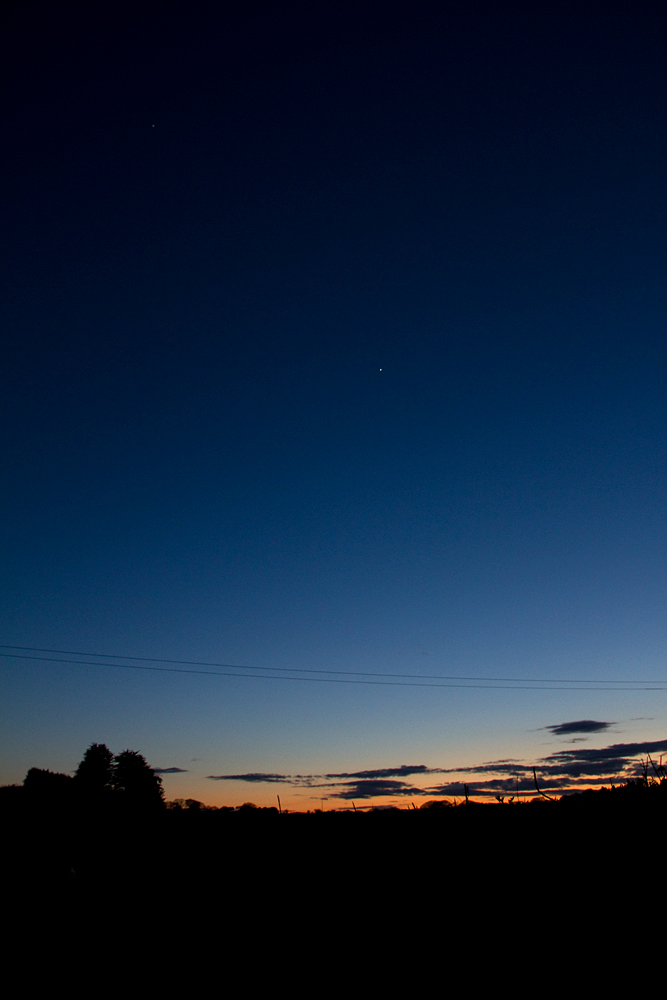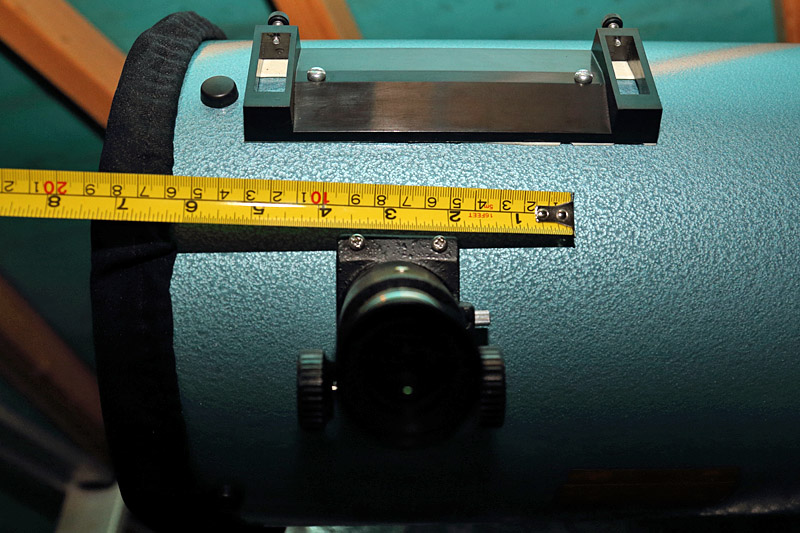
Jupiter (top left) and Venus, just after sunset. Canon EOS 7D with Canon EF-S 18-135mm IS lens
After a bit of a break (my last observing session had been on 27th November) I managed to get a bit of observing in, over the past two evenings (18th and 19th February). So far, 2012 has been very clear but what with work – my current temporary job means having to get up at 0615 – and temperatures often getting as low as -10°C/14°F, not conducive to wanting to get outside, I have been idle.
Rather than putting an observing session in each post, I’ll include the previous two in this one, starting with 18th February’s.
18th February 2012
Conditions: Chilly (2°C/35.6°F), slight breeze, no Moon, dew (torrential rain earlier in the afternoon had cleared away)
Transparency: III
Seeing: I-II
NELM: 6
Equipment: 18″ f/4.3 Dob; 22mm Televue Panoptic (90x), 8mm Televue Radian (247x), UHC, OIII filters
NGC 1982 (=M43) – I started off with an easy object, some ‘low-hanging fruit’ to get back into the observing groove. NGC 1982, a.k.a. M43, is on the Herschel list. It’s something I’ve looked at hundreds of times before but it is easily overshadowed by its immediate neighbour, the spectacular M42 which lies to the south. M43 is part of the same nebulous complex as M42 but appears to be separated from it by a dark gulf. It is smaller and fainter than M42 but, if the big nebula wasn’t there M43 would be a showpiece in its own right.
Very bright and fits into the same field of view as M42 at 90x. It is bright, comma-shaped and has a greenish-grey colour. In the centre of the comma’s ‘body’ there is a bright star, with a couple of fainter stars in the rest of the nebula.
247x shows extensive nebulosity with a ‘lumpy’ effect with dark areas in among the bright nebulosity. 90x, 247x + UHC
N.B. M42 in the 18″ is nothing short of absolutely spectacular. This was the first time I’d managed to observe it properly this winter, apart from a quick look in November when it was low on the horizon, and without filtration the centre portion, around the Trapezium, is bright green with dark lanes criss-crossing it. Nebulosity extends everywhere and it completely fills the field of view at 90x. I will attempt a sketch of this before the winter is out.
NGC 1762, galaxy in Orion – Easily found at 90x this is small, round and bright. There is a bright star superimposed on the foreground to the east. A fuzzy halo surrounds a bright stellar core. 90x, 247x
NGC 2023, nebula in Orion – Just S of NGC 2024, this is a bright reflection nebula around a star. 90x.
(Had a go at the IC434/B33 complex – the Horsehead Nebula – not seen as the transparency was not great).
NGC 1977, nebula in Orion – This is a large, fairly bright reflection nebula surrounding three stars. It is elongated east to west. The view is enhanced with the UHC filter but not by the OIII. 90x.
NGC 1682, galaxy in Orion – Fairly small, round and fairly bright. A diffuse halo surrounds a brighter core. 247x
NGC 1684, galaxy in Orion – Elongated 2:1 NNE-SSW, this is larger and brighter than 1682. It has a fuzzy halo surrounding a bright core. 90x, 247x.
Packed up at 2130. The good thing about this time of year is that you can have a reasonable session and still get indoors in time to watch Casualty and the Football League Show!
The following night, Sunday 19th, was even clearer, but cold, so I put the light screen up (I hadn’t bothered the previous evening) and wheeled the 18″ out for a short session. I had planned to observe H2500 objects in Monoceros but ended up losing my way a little and hopping around nearby constellations. I also spent some considerable time cruising the winter Milky Way and looking at IC434/B33
19th February 2012
Conditions: Cold (-4°C/24.8°F), no breeze, no Moon. Dry, with slight frost.
Transparency: II
Seeing: II-III
NELM: 6.1
Equipment: 18″ f/4.3 Dob, 2mm Televue Panoptic (90x), 15mm Televue Plossl (132x), 8mm Televue Radian (247x), UHC, OIII and Hß filters.
I began with another piece of low-hanging fruit, the easy to find and bright NGC 2261, Hubble’s Variable Nebula.
NGC 2261 (=Hubble’s Variable Nebula), nebula in Monoceros – Very easy to find, this is bright and fan-shaped, with the variable star R Monocerotis – which is the star associated with the nebula and gives it its variability – at its apex (on the southern end). The nebula is very bright, especially around and to the north of R Mon but fades out at the broadest part. A UHC filter makes no difference at all while OIII, as expected (NGC 2261 is a reflection nebula) kills the view. 90x, 132x + UHC, OIII filters.
NGC 2402, galaxy in Canis Minor – Located at the southern end of a chain of 4 stars, this is small, round and fairly bright. It has a diffuse halo surrounding a bright, stellar core. 90x, 132x, 247x.
NGC 2508, galaxy in Canis Minor – This lies to the east of two stars and is small, round and fairly bright. A diffuse halo brightens to the core and a stellar nucleus. 90x, 132x, 247x
NGC 2513, galaxy in Cancer – Easy to find, just north of NGC 2508. A round, bright, diffuse hal0 surrounds a bright core and stellar nucleus. 90x, 247x.
As the transparency was much improved over the previous evening, I had another go at looking at IC434/B33, the Horsehead nebula area. I did see it this time, although it was very faint, even with the Hß filter. This was only my second view of it, the first having been with Owen Brazell’s 20″ Dob at the Isle of Wight Star Party in 2010.
I packed up after a fairly short session.



